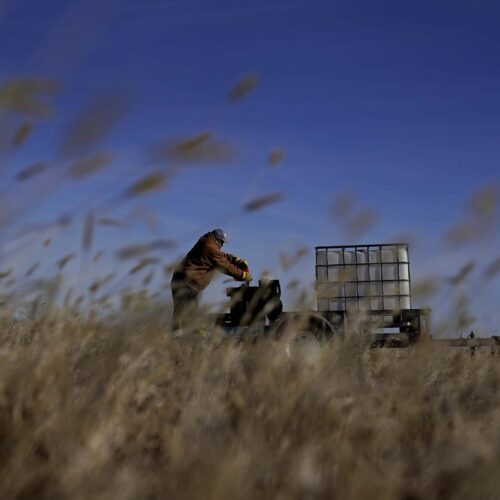Introduction
When President Joe Biden announced that he was reappointing Tom Vilsack as secretary of the U.S. Department of Agriculture, many advocates questioned whether the new administration was serious about tackling the agency’s institutional racism.
Vilsack presided over the USDA during the Obama administration. An investigation by the nonprofit news outlet The Counter found that the department foreclosed on Black farmers with pending discrimination complaints, used misleading census data to inflate its civil rights record and failed to sufficiently compensate farmers in class action discrimination suits. Many lost their farms as a result.
Over the past century, Black-owned land used for farming has dropped 85%. The loss harms rural Black communities and erodes generational wealth. Federal discrimination has played an outsized part.
But does the American Rescue Plan that Biden signed last week signal change is afoot? Inside the $1.9 trillion COVID-19 bill was $5 billion in direct relief to farmers of color.
The bulk of the funds will go toward paying off USDA farm loan debts and related taxes that have trapped farmers in “a cycle of debt,” Vilsack said. The remaining $1 billion aims to eradicate systemic racism at the USDA by supporting legal aid, forming a racial equity commission, providing scholarships to historically Black land grant universities and more.
“The thing that this whole legislation begs for is context,” said Pete Daniel, author and historian of agriculture and the South.
Daniel wrote Dispossession: Discrimination Against African American Farmers in the Age of Civil Rights, the essential text for understanding the USDA’s fractured relationship with African American farmers. During a phone interview with the Center for Public Integrity, Daniel explained the civil rights era roots of Congress’ historic debt relief.
*This conversation has been edited for length and clarity.

People are saying that the direct relief in the COVID-19 stimulus bill will benefit Black farmers in a way that no legislation has since the Civil Rights Act of 1964. But your book Dispossession cautions against that. Can you talk about the dangers of comparing the Civil Rights Act to this recent legislation?
During the ’60s, when people were looking to the federal government to do a lot of things about civil rights, the Department of Agriculture was busy dispossessing Black farmers. And that was done through any number of ways. …
Local committees were given enormous power over how federal money went into the counties, how it was spent and who got it. The [white] elite was elected year after year after year until they were challenged finally in 1964 at the height of the civil rights movement just after Freedom Summer when the [Student Nonviolent Coordinating Committee] workers realized that these committees were federal committees and that they could get their own people elected. The county committees weren’t willing to yield anything to the Black farmers.
Or look at the Farmers Home Administration which had up or down say over who got credit. One of the most vicious things they did was advance the [Black] farmer a little bit, so he could start planting and then halt the payments after that. And here he was with that crop planted but he couldn’t get any pesticides to kill the pests or herbicides to kill the weeds so he lost the crop.
Then the farmers were supposed to get educational materials from the extension service. There was, until 1965, what was called the Negro Extension Service, which did good work in as much as they had the resources to do it. But they were always under control of the white extension service.
What you have are these three federal agencies that had control over whether the farmers thrived or failed. And what they did was make sure that a lot of Black farmers failed.
In the ’60s, the very decade when people thought that African Americans were gaining voting rights and all of that, which they were, they were losing farms because of this discrimination. That was when most of the Black farmers were lost. And then you go through the ’70s and the trend continues. …
With that background, you can reasonably say that there’s no amount of money that’s going to bring back all those farms lost by African Americans between 1954 and 1980. They’re not even on the scale. Hopefully [the stimulus bill] will encourage the Black farmers who survived, and encourage younger Black farmers to prosper and encourage new farmers to come in. But it’s not the cure-all because so much has been lost. You can’t reconstruct a culture of farming that was destroyed by the Department of Agriculture.
How did the USDA’s treatment of Black farmers during the ’60s help to accelerate the decline of Black farming communities in the South?
Once you move away from the farm, you start breaking up communities. If there are several African American farmers in a certain community and they start losing their land and moving north, the communities are destroyed. And if they lose their land and don’t move north, what kind of jobs are open to them? Not many.
What parallels are there between the racist policies and practices African American farmers faced during the ’60s and the policies and practices they face today?
Even back during the Obama administration, the civil rights office at USDA has always been notorious for not doing anything for civil rights. And you’ve got Vilsack back, and he pledged that he would do better this time. Well, every secretary of agriculture since Orville Freeman in the ’60s says, ‘Oh we’re going to end this racism in the department,’ and of course none of them have. It’s pretty much an empty promise. And frankly, I don’t know how one would … get rid of the racism in the department because it’s so endemic.
What are some of the most significant steps that USDA, Congress and the new administration can take to help repair the government’s relationship with Black farmers?
I would start where the issue is — with the Black farmers — and learn all you can about what they’ve put up with and who has been treating them so poorly, and then take action toward the people who are discriminating. All those things I mentioned in the 1960s, which were vicious, mean things, nobody lost their jobs in the Department of Agriculture. I think one person was moved to another county. That was the most drastic action taken.
So the Department of Agriculture doesn’t want to make examples and you need to make examples of these people who are racist. They need to be held responsible.
April Simpson is a senior reporter at the Center for Public Integrity. She can be reached at asimpson@publicintegrity.org. Follow her on Twitter @aprilleticia.





Join the conversation
Show Comments